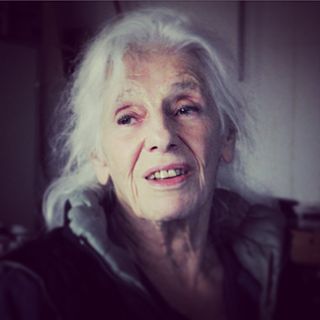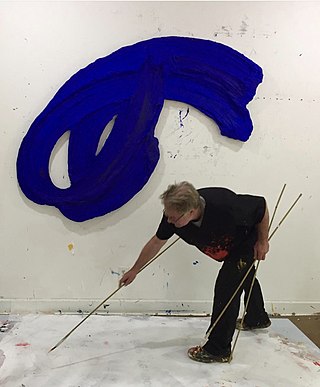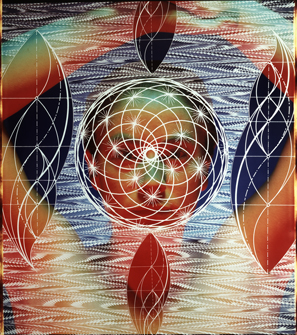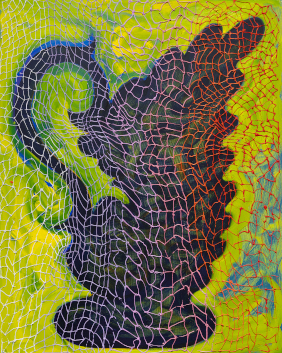Walter Darby Bannard was an American abstract painter and professor of art and art history at the University of Miami.

Josephine Gail Baer is an American painter associated with minimalist art. She began exhibiting her work at the Fischbach Gallery, New York, and other venues for contemporary art in the mid-1960s. In the mid-1970s, she turned away from non-objective painting. Since then, Baer has fused images, symbols, words, and phrases in a non-narrative manner, a mode of expression she once termed "radical figuration." She currently lives and works in Amsterdam, Netherlands.
Squeak Carnwath is a contemporary American painter and arts educator. She is a Professor Emerita of Art at University of California, Berkeley.

Alyson Shotz is an American sculptor based in Brooklyn, New York. She is best known for experiential, large-scale abstract sculptures and installations inspired by nature and scientific concepts, which manipulate light, shadow, space and gravity in order to investigate and complicate perception. Writers suggest her work challenges tenets of monumental, minimalist sculpture—traditionally welded, solid, heavy and static—through its accumulation of common materials in constructions that are often flexible, translucent, reflective, seemingly weightless, and responsive to changing conditions and basic forces. Sculpture critic Lilly Wei wrote, "In Shotz’s realizations, the definition of sculpture becomes increasingly expansive—each project, often in series, testing another proposition, another possibility, another permutation, while ignoring conventional boundaries."
Lita Albuquerque is an American installation, environmental artist, painter and sculptor. She is a part of the core faculty in the Graduate Fine Art Program at Art Center College of Design.
Laylah Ali (born 1968) is a contemporary visual artist known for paintings in which ambiguous race relations are depicted with a graphic clarity and cartoon strip format.

Melissa Miller is an American painter who is best known for what Art in America called "raucous allegorical paintings" of animals that balance storytelling, psychological insight and behavioral observation with technical virtuosity and formal rigor. She rose to prominence during a rebirth in figurative painting and narrative content in the early 1980s championed by curators such as Marcia Tucker and Barbara Rose, who both selected Miller for prominent surveys. Rose identified Miller among a group of iconoclastic "rule breakers," describing her work as "a wild kingdom … gone slightly berserk" in the struggle for survival, whose intensity recalled Delacroix. In a later Artforum review, Donald Kuspit called Miller's paintings "apocalyptic allegories" executed with meticulous old-master methods that articulated psychic states, existential problems and ecological concerns. Miller has exhibited at museums throughout the United States, including the Whitney Museum, New Museum, San Francisco Museum of Modern Art (SFMOMA), Museum of Fine Arts, Houston, and Hirshhorn Museum. Her work belongs to the public art collections of the Museum of Modern Art, National Museum of Women in the Arts, Albright-Knox Gallery and Museum of Fine Arts, Houston, among others, and she has received the Anonymous Was A Woman Award and Texas Artist of the Year Award. Miller lives and works in Austin, Texas.

Sharon Gold is an American artist and associate professor of painting at Syracuse University. Gold's artwork has been installed at MoMA PS1, Dia Art Foundation, Carnegie Mellon University, Rose Art Museum at Brandeis University, Everson Museum of Art, and Princeton University Art Museum. She was a fellow at MacDowell Colony. Gold's work has been reviewed by Arthur Danto, Donald Kuspit, Ken Johnson, and Stephen Westfall in a variety of publications from Artforum to the New York Times, New York Magazine, Arts Magazine, Art News, and many others. She also taught at Princeton University, Pratt Institute, Virginia Commonwealth University, University of Texas at San Antonio, San Francisco Art Institute, and the Tyler School of Art. Gold received a National Endowment for the Arts fellowship and wrote for Re-View Magazine, M/E/A/N/I/N/G/S, and Artforum. Her artwork spans across minimalism, monochromatic abstraction, geometric abstraction, and representational painting and is conceptually informed by structuralism, existential formalism, and feminist theory.

Gisela Colon is an American international contemporary artist who has developed a unique vocabulary of Organic Minimalism, breathing lifelike qualities into reductive forms. Operating at the intersection of art and science, Colon is best known for meticulously creating light-activated sculptures through industrial and technological processes. Drawing from aerospace and other scientific realms, Colon utilizes innovative sculptural materials such as carbon fiber and optical materials of the 21st century, to generate her energetic sculptures. Colon's gender-fluid sculptures disrupt the traditional view of the masculine minimal object, by embodying qualities of energy, movement and growth, through a merger of industrial with the organic.

Donald Martiny is an American artist. His abstract paintings are related to both action painting and Abstract expressionism.
Beth Ames Swartz is an American visual artist. While primarily an abstract artist, her paintings often incorporate words and symbols representing philosophical concepts shared by people of different cultural world views. Her daughter, Julianne Swartz, is a well-known, New York based artist.
Martha Joanne Alf was an American artist. Her work consists of paintings, drawings and photographs of everyday objects, including pears and rolls of toilet paper.

Laurie Fendrich is an American artist, writer and educator based in New York City, best known for geometric abstract paintings that balance playfulness and sophistication. Her work has been featured in solo exhibitions in New York, Los Angeles and Chicago, a retrospective at the Williamson Gallery at Scripps College (2010), and group shows at MoMA PS1, the Los Angeles County Museum of Art, and the National Academy of Design, among many venues. She has received reviews in publications including The New York Times, Artforum, Art in America, Arts Magazine, ARTnewsPartisan Review, and New York Magazine. Fendrich has been awarded fellowships from the Guggenheim Foundation (2016), Brown Foundation at the Museum of Fine Arts, Houston, and National Endowment for the Arts (1983–4). She has been an educator for more than four decades, notably at Hofstra University (1989–2014), and a regular essayist for The Chronicle Review at The Chronicle of Higher Education.

Ellen Carey is an American artist known for conceptual photography exploring non-traditional approaches involving process, exposure, and paper. Her work has ranged from painted and multiple-exposure, Polaroid 20 x 24, Neo-Geo self-portraits beginning in the late 1970s to cameraless, abstract photograms and minimal Polaroid images from the 1990s onward, which critics often compare to color-field painting. Carey's sixty one-person exhibitions have been presented at museums, such as the Amon Carter Museum of American Art, International Center of Photography (ICP) and Wadsworth Atheneum Museum of Art, alternative spaces such as Hallwalls and Real Art Ways, and many commercial galleries. Her work is in numerous museum collections, including those of the Metropolitan Museum of Art, Whitney Museum of American Art, Los Angeles County Museum of Art, Centre Pompidou, and Smithsonian American Art Museum. In 2019, she was named one of the Royal Photographic Society (London) "Hundred Heroines", recognizing leading women photographers worldwide. Los Angeles Times critic Leah Ollman describes her photography as "inventive, physically involving, process-oriented work" and her recent photograms as "performative sculptures enacted in the gestational space of the darkroom" whose pure hues, shadows and color shifts deliver "optical buzz and conceptual bang." New York Times critic William Zimmer wrote that her work "aspires to be nothing less than a reinvention, or at least a reconsideration, of the roots or the essence of photography." In addition to her art career, Carey has also been a longtime educator at the Hartford Art School and a writer and researcher on the history of photography.

Judith Murray is an American abstract painter based in New York City. Active since the 1970s, she has produced a wide-ranging, independent body of work while strictly adhering to idiosyncratic, self-imposed constants within her practice. Since 1975, she has limited herself to a primary palette of red, yellow, black and white paints—from which she mixes an infinite range of hues—and a near-square, horizontal format offset by a vertical bar painted along the right edge of the canvas; the bar serves as a visual foil for the rest of the work and acknowledges each painting’s boundary and status as an abstract object. Critic Lilly Wei describes Murray's work as "an extended soliloquy on how sensation, sensibility, and digressions can still be conveyed through paint" and how by embracing the factual world the "abstract artist can construct a supreme and sustaining fiction."

Lynn Aldrich is an American sculptor whose diverse works draw on a wide range of high and low cultural influences and materials. Her work can range from what art writers describe as "slyly Minimalist meditations" on color, light and space to whimsical "Home Depot Pop" that reveals and critiques the excesses—visual, formal and material—of unbridled consumption. Critics Leah Ollman and Claudine Ise of the Los Angeles Times have described Aldrich's art, respectively, as a "consumerist spin on the assemblage tradition" and a "witty and inventive brand of kitchen-sink Conceptualism" LA Weekly critic Doug Harvey calls her "one of the most under-recognized sculptors in L.A.," whose hallmarks are the poetic transformation of found/appropriated materials, formal inventiveness and restless eclecticism. Aldrich has exhibited at the Museum of Contemporary Art, Los Angeles (MOCA), Los Angeles County Museum of Art (LACMA), Hammer Museum, Santa Monica Museum of Art, and venues throughout the United States and Europe. She has been recognized with a Guggenheim Fellowship (2014) and public art collection acquisitions by LACMA, MOCA Los Angeles and the Portland Art Museum, among others.

Louise Belcourt is a Canadian-American artist based in New York, known for elusive, largely abstract paintings that blend modernist formal play, a commitment to the physical world, and a visual language that shifts between landscape and the body, architecture and geometric form. New York Times critic Ken Johnson writes of her earlier work, "balancing adroitly between Color Field abstraction and Pop-style representation, Ms. Belcourt's paintings invite meditation on the perceptual, the conceptual and how our minds construct the world." Describing her later evolution, David Brody writes in Artcritical, "Hard-nosed Canadian empiricism and Brooklyn grit seem to combine in Belcourt’s work to undermine stylistic stasis."

Judith Simonian is an American artist known for her montage-like paintings and early urban public art. She began her career as a significant participant in an emergent 1980s downtown Los Angeles art scene that spawned street art and performances, galleries and institutions such as Los Angeles Contemporary Exhibitions (LACE) and Los Angeles Institute of Contemporary Art (LAICA), before moving to New York City in 1985.

Harriet Korman is an American abstract painter based in New York City, who first gained attention in the early 1970s. She is known for work that embraces improvisation and experimentation within a framework of self-imposed limitations that include simplicity of means, purity of color, and a strict rejection of allusion, illusion, naturalistic light and space, or other translations of reality. Writer John Yau describes Korman as "a pure abstract artist, one who doesn’t rely on a visual hook, cultural association, or anything that smacks of essentialization or the spiritual," a position he suggests few post-Warhol painters have taken. While Korman's work may suggest early twentieth-century abstraction, critics such as Roberta Smith locate its roots among a cohort of early-1970s women artists who sought to reinvent painting using strategies from Process Art, then most associated with sculpture, installation art and performance. Since the 1990s, critics and curators have championed this early work as unjustifiably neglected by a male-dominated 1970s art market and deserving of rediscovery.

Wendy Edwards is an American artist known for vibrant, tactile paintings rooted in organic forms and landscape, which have ranged from representation and figuration to free-form abstraction. Her work has been strongly influenced by the 1970s Pattern and Decoration movement and its embrace of ornamentation, repetition, edge-to-edge composition, sensuality and a feminist vision grounded in women's life experience. Critics note in Edwards's paintings an emphasis on surfaces and the materiality of paint, a rhythmic use of linear or geometric elements, and an intuitive orientation toward action, response and immediacy rather than premeditation. In a 2020 review, Boston Globe critic Cate McQuaid wrote, "Edwards's pieces are exuberant, edgy, and thoughtful … [her] sweet, tart colors and delicious textures make the senses a gateway into larger notions about women and men, creation and mortality."


















